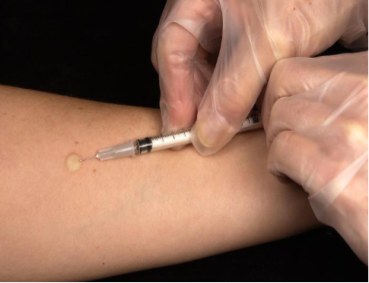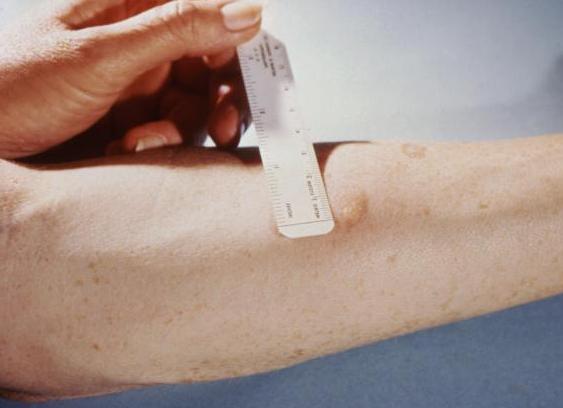Early identification of individuals infected by TB bacteria is important in preventing and controlling TB disease. Treatment given to individuals in the early phase of infection, called latent TB infection, can help to stop the infection from progressing.
What is Latent TB Infection (LTBI)?
- TB is not uncommon in Malaysia. Statistics in 2011 showed that TB in children is increasing.
- While adult usually develop TB disease from TB bacteria that become active again in their body (reactivation TB), children are usually infected by TB bacteria from an adult with active TB disease (primary infection).
- Not every child becomes sick after infection by TB bacteria.
- Some children remain well despite the presence of TB bacteria in their body. These children have Latent TB Infection (LTBI).
- When TB bacteria multiply and damage the tissue in the body, the child becomes sick and this child has TB disease.
- Hence a child with LTBI has these features:
- A positive Tuberculin test indicating the presence of TB bacteria in the body
- No symptoms
- Normal physical finding
- Cannot spread TB bacteria to others
- Once infected, an individual with LTBI has a 5-10% risk of the TB bacteria reactivating in the later part of life.
- The risk of developing TB disease is higher in the high risk group, especially children and those with a weakened immune system. Children with LTBI younger than 5 years old have a 10-20% risk of developing TB disease.
How to diagnose LTBI in children?
As children with LTBI have no symptoms or abnormal physical findings, the diagnosis of LTBI is challenging. Currently, there are 2 methods to determine if a person has been infected by TB bacteria:
- Tuberculin Skin Test (TST)
- TST is sometimes referred to as Mantoux test. It is a test to determine if a person is infected by TB bacteria by measuring the immune response of the body (delayed type hypersensitivity) to TB bacteria. A solution containing the extract of TB bacteria is injected beneath the skin and the reaction at the site of injection is measured 72 hours later.
- The limitation of TST is that it depends on the ability of the body to mount an immune response to the test. A child with a weak immune system will not produce a reaction to the test even if TB bacteria are present in the body.


Mantoux test
Nevertheless, TST is a more sensitive test in children; hence TST is the recommended test for children suspected to have LTBI.
- IGRA (Interferon Gamma Release Assays)
- IGRA is a blood test to determine if a person is infected by TB bacteria by measuring the immune response of the body (interferon gamma) to TB protein.
- However, its use is limited in children with LTBI, especially children younger than 5 years due to low sensitivity. Currently, IGRA is not recommended for children with suspected LTBI
What to do when a child has contact with person with TB?
- When a child has contact with a person with TB disease, caregiver(s) should bring the child for medical consultation. Some children are identified from the contact tracing process of an adult with newly diagnosed TB.
- First, Tuberculin Test is done to detect the presence of TB bacteria in the body. If the test is positive (generally when it is reported as >10mm), a thorough physical examination is carried out to look for any signs of tissue damage by TB bacteria. A chest X-ray is also performed to look for changes caused by TB bacteria in the lungs.
- Those with abnormal physical or X-ray findings are investigated carefully for TB disease.
- Those with normal physical and X-ray findings are said to have LTBI.
- Children with LTBI will be evaluated for their risk of developing TB disease.
Is there treatment for LTBI?
- High risk children with LTBI are offered treatment for LTBI.
- Treatment for LTBI consists of one or two anti-TB drugs. The commonest anti-TB drug used in children is isoniazid. Isoniazid has to be taken on an empty stomach for 6-9 months.
- Isoniazid is generally a safe drug in children. The common side effects include:
- Loss of appetite
- Stomach upset
- Vomiting
- Yellow skin or eyes
- Aches or tingling sensation of fingers or toes
- There are alternative treatment regimen for LTBI in children. The choice of regimen will be discussed with you by your healthcare provider.
- It is important for caregivers to ensure that the course of treatment is completed as instructed in order to kill the TB bacteria
How to ensure the course of treatment is completed as instructed?
It takes great effort to serve all the medicines to a well child as instructed. Some tips to keep track of the medicines:
- Serve the anti-TB drug(s) at the same time everyday
- Set an alarm as a reminder
- Keep the drug(s) in a place where it is unlikely to be missed
- Write a reminder and paste it at a place it is unlikely to be missed
- Use a calendar to check off the days you have served the drug(s)
| Last Reviewed | : | 28 August 2020 |
| Writer | : | Dr. Chan Kwai Cheng |
| Accreditor | Dr. Revathy Nallusamy | |
| Reviewer | : | Dr. Zainab bt. Kusiar |







